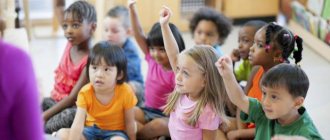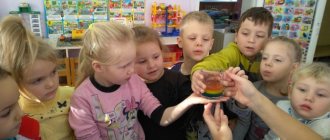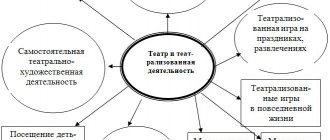Methods and techniques for working with children to familiarize themselves with fiction
• Puppet and shadow theater, flannelgraph.
• Filmstrips, movies, TV shows.
Reading as part of a speech development lesson.
• It can be logically related to the content of the lesson.
• Reading can be an independent part of the lesson.
The main methods are the following
:
1. Reading by the teacher from a book or by heart. This is a literal rendering of the text.
2. The teacher's story. This is a relatively free transfer of text. Storytelling provides great opportunities to attract children's attention.
3. Staging. This method
can be considered as a means of secondary
acquaintance with a work of art
.
4. Learning by heart. The choice of transmission method depends on the genre and age of the listener.
Traditionally in the methodology
speech development, it is customary to distinguish two forms
of working
with books in kindergarten: reading and storytelling.
Children of primary preschool age are taught a love and interest in books and illustrations, the ability to focus attention on the text, hear it to the end, understand the content and respond emotionally to it. Starting from the younger group, children are introduced to the distinction between genres. At this age, children are able to understand and remember a fairy tale and repeat a song, but their speech is not expressive enough.
In middle preschool age, work
to develop in children the ability to perceive
a literary work
, the desire to respond emotionally to the description of an event. Children are taught to answer questions about whether they liked the fairy tale or the story, what it is about, what words it begins and ends with.
In older preschool age, a strong interest in books arises and a desire to listen to them read. Accumulated life and literary
experience gives the child the opportunity to understand the idea of the work, the actions of the characters, and the motives of behavior.
Children begin to consciously
relate to the author's word, notice the features of language, figurative speech and reproduce it.
The main role in training belongs to special classes. Classes are supplemented and interact with special didactic games outside of class.
Introduction to fiction
cannot be limited to classes. Reading and storytelling of books is organized at all moments of the life of children in kindergarten; it is associated with games and walks, with everyday activities, and work.
In order to develop children's interest in fiction
a literary center
is created in each group , this is a calm, comfortable, aesthetically designed place where children have the opportunity to communicate with books, look at illustrations, magazines, and albums. There are a number of requirements for the installation of a corner:
Reading and telling fairy tales in kindergarten
Elena Kuzina
Reading and telling fairy tales in kindergarten
Since ancient times, people have used fairy tales for educational purposes. Why fairy tales ? Yes, because a fairy tale is the most understandable way for a child to transmit and receive information. Despite the fact that our children watch TV and play computer games, they still like it when educators, and sometimes parents, read and tell fairy tales . Therefore, in my opinion, the topic of reading and telling fairy tales in kindergarten is the most relevant at the moment.
The whole point here is in the peculiarities of children's perception - children perceive all information through OUR feelings. After all, they look at the world through OUR eyes. They remember OUR gestures and facial expressions, OUR reactions to objects and situations. They carefully observe the manifestations of OUR feelings and emotions, and then also look at the world.
For example, a mother, in the presence of a child, was sincerely happy about a blooming flower, a blue sky or a beautiful butterfly. The child understood: “This is something very good, since it made my mother so happy, it means that I will perceive it as good, I will rejoice at the flowers and the sky...” And if the mother screamed at the sight of a little mouse, and fear was reflected on her face, then the child will perceive mice as something dangerous for himself and his loved ones. Most likely, he will also begin to be afraid of mice or dislike them.
Therefore, children perceive only the information that is transmitted to them in direct communication with adults and which is colored by a variety of intonations and emotions. And where, if not in fairy tales , can one look for vivid images that are so easily and vividly imagined by a child’s consciousness and remain in it for many years?
Listening to a fairy tale , the child “sees”
her heroes, empathizes with them, rejoices with them, learns from them, wants to be like them, or vice versa, promises himself never to do that.
A fairy tale touches a child’s soul, makes him think, change something in himself, and helps him find a way out of the current situation. Fairy tales contrast good and evil, generosity and greed, courage and cowardice, kindness and cruelty. Without unnecessary complications fairy tales directly and intelligibly , using vivid examples, explain to the child that to be bad means to act to one’s detriment, and to be good is right and beneficial.
After all, a reward always awaits a positive hero. The language of fairy tales is much closer and more understandable to a child than boring parental notations and comments.
A fairy tale does not cause internal resistance, so the child is able to listen to it. In fairy tales , children are not lectured, blamed or forced to talk about their difficulties and problems - they simply listen and draw their own conclusions. A fairy tale can do a lot : it helps you get rid of the fear of the dark and fall asleep peacefully, it teaches you how to overcome anxieties and conflicts.
Through a fairy tale, a child can be presented with any information, even that which he refused to listen to and perceive in a conversation with adults. After all, listening to fairy tales , children involuntarily find echoes of their own lives in them and strive to use the example of a positive hero in the fight against their problems. A fairy tale can instill hope in a child, which means he will have the strength to go to success.
READING AND TELLING FAIRY TALES IN KINDERGARTEN
The artistic word is widely used in working with preschool children. Children love to listen to folk tales , poems, stories . Interesting content, rich imagination, vivid artistic images attract the child’s attention, bring him joy and, at the same time, have an educational effect on him.
The value of literary works lies in their influence on the comprehensive development of the child. Realistic stories , fairy tales , and poems are one of the forms of knowledge of the world for children; they help the child clarify his ideas about the surrounding reality, gradually enrich him with new concepts, and expand his life experience.
The literary word is perceived through reading and listening . In the first case, perception is direct, in the second - through the performer (reader or storyteller , who is, as it were, an intermediary between the author and performer.
Mastering the art of artistic reading and storytelling is the professional responsibility of a kindergarten .
The artistic execution of a literary work requires careful preparation. Preliminary work on a work is creative work. In the process of preparation, you need to study this work well, comprehend its idea, and understand the author’s intention. Understanding the idea will help you determine your attitude to the work as a whole, to the characters and their actions, and will help you see the images and the setting of the action more clearly.
In order to capture the attention of children-listeners, the teacher’s speech must be emotional and convincing. And this will happen only as a result of careful preparation, during which the teacher becomes so accustomed to this work that he will be able to convey his attitude to what he is talking about.
Creative imagination provides great assistance in the execution of a work of art. You need to see what you are talking .
In the process of creative work on a work, the means of artistic transmission are also outlined. The main means of expressive sound of a work is the voice. The most varied intonations of the voice, all possible shades of its strength, and the pace of reading corresponding to the content will help create a truthful, convincing picture of the work being performed.
The teacher’s task is to skillfully use all the richness of the shades of his voice.
In the process of preparing for reading or storytelling, much attention should be paid to mastering the text. Regardless of the type of performance ( reading from a book , reading or telling by heart , or the genre of the work being performed, the teacher must master the text well. Knowledge of the text of a work of art for storytelling in most cases should be verbatim.
Works for preschool children are small in volume and easy to remember. The literal transmission of the text when narrated preserves the style and integrity of the entire work.
The teacher needs, based on a deep, complete understanding of the content of the text being performed, to easily find and use appropriate artistic reading and storytelling .
The goal of our work is to teach children to consciously relate to their feelings, to their inner world, in other words, to contribute to the formation of their self-awareness, to develop the ability to manage their feelings through folk tales .
At the initial stage of work, the task is to awaken in children the desire to listen to the telling of a fairy tale , follow the development of the action, and sympathize with the positive characters.
For younger children, we do not read fairy tales , but tell them : this enhances the emotional impact, which, in turn, contributes to the understanding of the main meaning of the fairy tale . After all, when the teacher looks not at the book, but at the children, he seems to be talking to each child, and this develops the very important ability to listen and understand monologue speech.
When telling fairy tales, it is good to use a tabletop theater, a magnetic board or flannelograph, or display illustrations. To interest children in the upcoming story of a fairy tale, you can also use sayings or short poems of your own composition.
When children enter a group, many educators are faced with the fact that in individual conversations with parents it turns out that very few of the children’s parents read fairy tales , much less tell them , trying to replace the “living”
the word by showing videotapes or DVDs.
Therefore, it is good to hold a parent meeting on the topic “What does a fairy tale ?”
, during which the teacher
will talk about what a fairy tale , give recommendations to parents on selecting fairy tales in accordance with the age of the children, as well as methodological advice (place and time of reading or telling fairy tales ; the need to prepare the child for listening to a fairy tale , returning to what has been read ; conversations on what they have read - attitude towards the characters and assessment of their actions; retelling fairy tales by children ; looking at illustrations , drawing on the themes of fairy tales ).
Both educators and parents should always remember that reading and telling fairy tales to preschool children is necessary because:
• Preschool age is the age of fairy tales .
• A fairy tale is a special way of mastering the world, allowing a preschooler to understand and in his own way systematize the stream of events that falls on him from all sides and does not want to wait until the child’s thinking becomes “scientific”
.
And such, albeit unscientific, albeit temporary, systematization is necessary for the child: it reduces the “tension of understanding
,” harmonizes the child’s consciousness, makes the world understandable, and therefore pleasant and comfortable. Makes it a world in which it is interesting to live, which you want to better explore and understand more deeply.
• Fairy tales play a very important role, since they contain a powerful, life-affirming motif that every child discovers for himself. They give the child the opportunity to believe that Evil will always be punished and Good will triumph.
• A fairy tale opens the gates to the richest world of culture for a child, helping him to better navigate various life situations.
• A fairy tale awakens and captivates a dream. She gives the child the first feeling of heroism... She teaches him courage and loyalty, teaches him to contemplate human destiny, the complexity of the world, the difference between “truth”
from
"falsehood"
.
• From contact with a fairy tale , a child develops his own impression. The younger the child, the more this impression differs from the vision of an adult. The child does not yet know how to think logically, and the fairy tale does not teach him directly. Fairy-tale images , style, and language gradually convey vital information to the baby.
• The tale poses and helps solve moral problems. In it, all the heroes have a clear moral orientation. They are either entirely good or entirely bad. This is very important for determining the child’s sympathies, for distinguishing between good and evil, for streamlining his complex feelings. The child identifies himself with a positive hero.
Source
Introduction
Preschool childhood as a period in human life plays an exceptional role in shaping what not only each individual person will become, but also all of humanity and the world as a whole. The educational, ideological, moral, cultural and physical priorities laid down in preschool childhood determine the life path of generations and influence the development and state of the entire civilization. Now it is necessary to pay as much attention as possible to the formation of the child’s inner world, to nurturing the creative principle in him. Since in the process of communicating with a book, a child not only learns the past, present and future of the world, but also learns to think, analyze, and develops creatively; thus, the moral and cultural basis of his personality is formed. A special place in preschool institutions is occupied by introducing children to fiction as an art and a means of developing intelligence, speech, a positive attitude towards the world, love and interest in books. A children's book that a child likes captivates him so much that he does not separate himself from what is happening in it, immersing himself in it, imagining to the smallest detail the events and the process of his participation in what is depicted. Such qualities are characteristic of children of older preschool age. Thus, cultivating in children such feelings as compassion, condemnation, anger, surprise.


